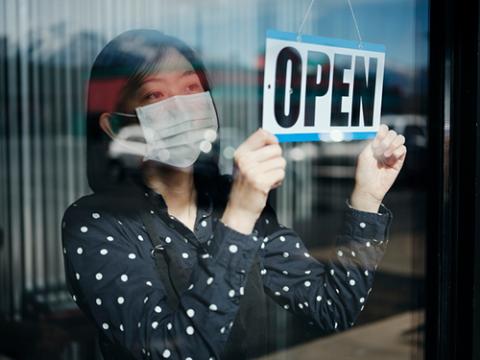Four Ways Retailers Can Thrive After the Pandemic

In the 12 months since the start of the COVID outbreak in the U.S. there have been dramatic changes within the retail industry. Massive spikes in demand put tremendous pressure on “essential” retailers, while others faced unprecedented challenges as stores were shuttered and foot traffic declined. With health and safety top of mind and various restrictions in place, consumers’ purchases and shopping methods were altered. They shifted their spending patterns from travel and hospitality to durable goods and consumables, especially home improvements.
In addition, there was a massive acceleration in the adoption of e-commerce as many consumers shopped from home.
It seems that the shift to online shopping will not be changing any time soon – – 74% of US consumers surveyed by Publicis Sapient last year indicated that they expect to shop online more in the future. Grocery has seen historic change: Our research also found that 50% of shoppers who try online grocery say they would be willing to use the service more in the future. Although we anticipate online grocery usage to gradually decrease as vaccination rollout continues, restrictions ease, and consumers begin dining out more, we believe consumer adoption will continue to grow.
With the shift to online shopping and digital channels is likely to continue, there are several key areas that retailers must prioritize in order to thrive after the pandemic.
Continued Investment in Fulfillment Flexibility
In order to adapt to new consumer needs throughout the pandemic, retailers had to put extra focus on contactless fulfillment methods like buy online pickup in store (BOPIS) and curbside pickup. These offerings not only provided consumers with a safe way to get products, but also added convenience to their daily lives. As a result, fulfillment flexibility is now table stakes - consumers today expect to be able to order digitally, with the option to pick up their items in-store or have them delivered.
In fact, we found that BOPIS or curbside pickup is the number one fulfillment preference many consumers across various product categories – especially for household staples and apparel staples.
Retailers must continue to expand fulfillment options – offering curbside, BOPIS, reserve online, pickup in store (ROPIS), as well as same-day delivery, while simultaneously investing in efficiency. For example, sales associate picking tools can boost your UPH up to the 60 to 80 range if you have accurate plan-o-grams – close to the fully automated picking technology, yet without the capital costs.
Reimagining the Store
The best, most profitable model for digitally-enabled stores remains an open question. Yet tantalizing hints exist. For example, Target was able to achieve a class-leading profitability (twice its competitors) by, in part, fulfilling 80% to 90% of online orders through their stores. COVID has crystalized a view that the number of stores and the configuration of those stores must be reconsidered.
Some retailers feel that they need fewer, larger stores with more significant experiences in-store and dedicated micro fulfillment areas. For example, Loblaws, a leading grocer based in Canada, has invested in local and micro fulfillment for its grocery business as well. Others, such as Target, are expanding smaller footprints stores in urban locations. There is no one answer, but generally we believe fewer but larger stores is one outcome, and stores with large square footage will have a dedicated fulfillment area.
Focus on Profitability
Most retailers have been able to maintain profitability even as their e-commerce business has grown. They achieve this by aggressive cuts in promotional activity, an increase in pricing power due to product scarcity, and by putting off capital investments for 6 to 12 months. But this cannot last.
Retailers are increasingly realizing that although they can sell effectively with e-commerce, trying to generate profit is much more difficult. We feel that retailers will be forced to invest in customer data – CDPs and marketing uses cases especially, and then quickly pivot to incremental high-profit revenue sources like shopper marketing (advertising) platforms and continued cost cuts. Simultaneously, we expect retailers to make major new investments in supply chain control towers, inbound supply chain optimization, and, most importantly, outbound or ‘promise to delivery’ technologies. These solutions tend to reduce shipping costs, return rates, and inventory holding costs. For example, Walmart and Target have recently announced major supply chain investments.
Turn Data Insights into a Competitive Advantage
With the shift to online shopping, retailers have access to more data than ever before, giving them an opportunity to build stronger relationships with customers and create additional revenue streams. Most large, sophisticated retailers use insights from data to create more personalized experiences and offerings.
Some are also exploring ways to monetize their data through investments in subscription models, paid loyalty programs, digital games or digital licenses, exclusive access to physical spaces, and early access to products. Additionally, we’ve observed that some retailers are exploring entering adjacent market areas that they had never considered, and talk of becoming marketplaces, which opens the door for millions of new products.
With consumers’ ability to switch from one retailer to another with just the click of a button, it’s critical for retailers to understand how to interpret and implement data insights to differentiate themselves from their competitors and create lasting relationships with consumers.
One year later and U.S. retail has been reshaped. E-commerce has reached levels we hadn’t expected for at least two or three years from now. Over 30 major retail brands are bankrupt, and others are permanently weakened and may never recover. However, 2020 saw a 6%-plus increase in sales across the retail industry, which is surely a positive side as we look to emerge from COVID restrictions. With the right strategy and investments, and a relentless focus on new consumer expectations, retailers can position themselves for the post-pandemic future.
Hilding Anderson is head of retail strategy, North America, at Publicis Sapient.




